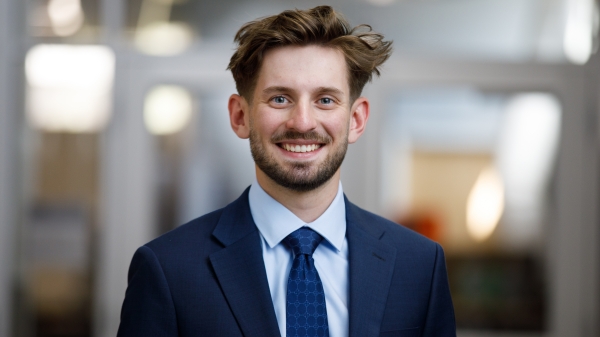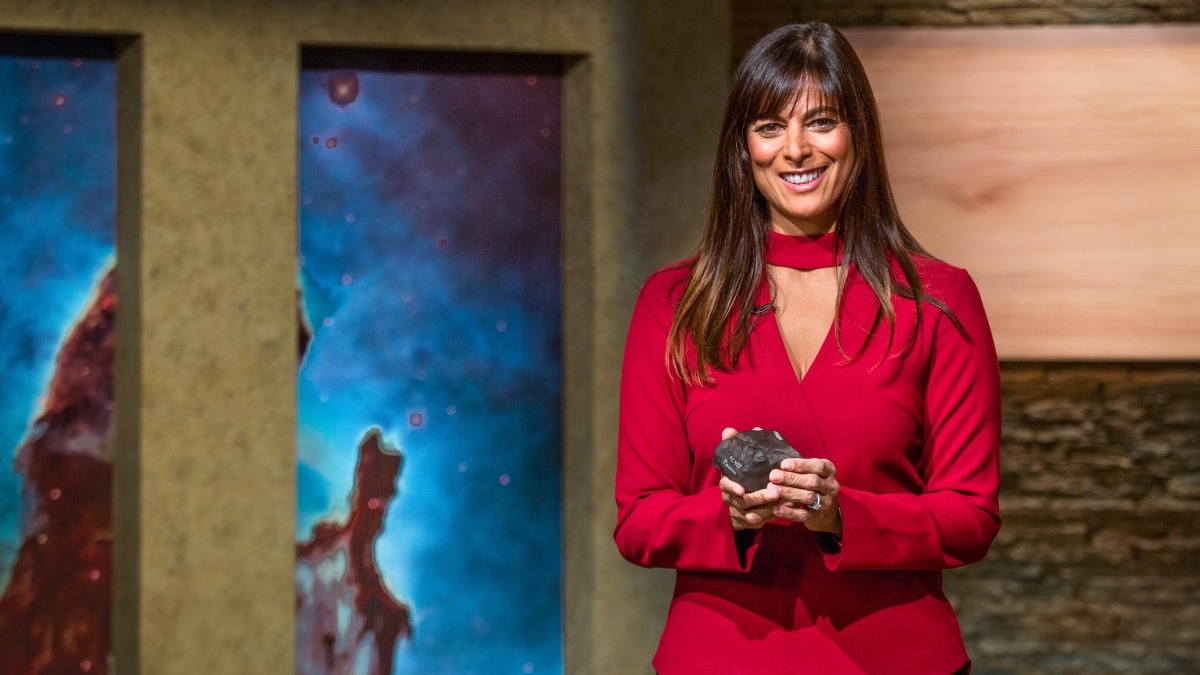Meenakshi Wadhwa has looked up her whole life.
At the Himalayas, looming over her hometown of Chandigarh in northern India, formed 40 to 50 million years ago by two massive continental plates. And to the vast gulf of space that sends chunks of planets and moons and asteroids streaking down through the atmosphere to be put into her hands, under her microscope and into her mind.
“They’re incredible,” the planetary geologist said. “I still get chills when I hold a piece of an asteroid formed 4½ billion years ago. The scale of that time period when you think about it, it’s hard to wrap your mind around it, but it’s so thrilling to think you actually can look back in time through these objects. It’s so fun to just imagine where they’ve been and what they’ve seen and what they’ve been witness to. For me that’s always been a thrill and I’ve never lost that excitement.”
Now Wadhwa is bringing her lifelong sense of wonder to Arizona State University’s School of Earth and Space Exploration as its new director.
She plans to scale up the school’s explorations, offer more hands-on opportunities for students, add more engineers to the faculty, jointly build programs with the Ira A. Fulton Schools of Engineering, and add more partnerships with NewSpace companies, which can range from SpaceX to two guys in a garage.
As a child, Wadhwa gathered rocks in her backyard and stood entranced by the mountains, fascinated by the scale of the processes that created them. After she earned her BS in geology at Panjab University, her thoughts turned to other worlds.
“How cool would it be to do geology on other planets? What a wonderful thing to be trained in this field and be able to transfer your skills to do geology on other worlds?”
But planetary geology wasn’t being taught widely across India at the time. She applied to schools in the United States and ended up choosing Washington University in St. Louis, which had a very broad program in planetary science. However, she didn’t know what she wanted to focus on. Then one day a professor showed her a Martian meteorite.
“Would you be interested in studying this?” the professor said. “You’re trained in geology; you know what rocks are. This rock actually comes from Mars. Would you like to study it for your dissertation?”
Wadhwa had an epiphany.
“I realized at the time there were actually rocks from these other planets in our solar system that we had access to,” she said. “Strangely enough, I hadn’t had that realization before. I was hooked.”
Since then, like those rocks, she’s gone far. Asteroid 8356 has been named 8356 Wadhwa in recognition of her contributions to meteoritics and planetary science.
Wadhwa has been on two Antarctic expeditions hunting meteorites. (She calls them the highlights of her field geology career.)
Antarctica is the best place to find meteorites. Its dry, cold climate perfectly preserves the asteroid fragments that crash to Earth. Ice sheets corral them into areas where they’re relatively easy to collect and winds screaming across the surface expose buried specimens.
“It’s such a strange place,” Wadhwa said. “It doesn’t capture very well in photographs, for one thing. It looks white and bland. But when you’re there, the scale … you have these 360 views of these vast expanses of ice and snow and just a big sky. … It’s the most beautiful continent I’ve ever been to. Just the experience of being camped in a remote location with six of your best friends and colleagues and working there for two months at a time, living in a tent — sharing the tent you get to know them very well.”
Prior to her new appointment as school director, she was director of the Center for Meteorite Studies at ASU, the world’s largest university-based collection with about 2,000 different types of meteorites in its 40,000-specimen collection.
Few things intrigue people as much as meteorites. The meteorite identification program was suspended nine years ago because the center was swamped by requests. On the one day the school offers to identify meteorites — Earth and Space Exploration Day, held each fall — people come from across the country. At a recent event, one man and his son drove from Clearwater, Florida. (They didn’t have a meteorite. People rarely do.)
When Wadhwa was curator at the Field Museum in Chicago, a meteorite shower hit the city. People called the police, thinking vandals were throwing rocks at their houses. The police confiscated many of the meteorites. “At the police station they were lined up like suspects,” she said.
Wadhwa has roles on two missions currently in flight. She is a collaborating scientist on the Sample Analysis at Mars instrument on the Mars Curiosity Rover and a science team member on the Japanese Hayabusa2 sample return mission to asteroid Ryugu.
The School of Earth and Space Exploration was among the first interdisciplinary schools established at ASU, in 2006. The idea was to put scientists and engineers together in the same silo and have them work together. Wadhwa arrived from the Field Museum later that year.
“I’ve been here since the inception of the school and I’ve seen its evolution,” she said. “Outside of ASU there was a lot of skepticism about what we were doing here in terms of trying to bridge the cultures of science and engineering and furthering exploration of Earth, space and the solar system beyond. We’ve shown in the last 10 to 12 years that the school has been around that this is a model that works. Our trajectory has been tremendous.”
The school has 10 instruments or missions in flight. Eight instruments are in development and nine missions are in development.
“Every time I look at the list there’s new additions to that,” Wadhwa said. Her predecessor, Lindy Elkins-Tanton, is leading the Psyche mission to a metal asteroid (the second woman in history to lead a NASA deep space mission). “We’re well situated because of the great leadership we’ve had in the past.”
She discussed her plans for the school, which begin with scaling it beyond showing that it’s a model that works.
“When people hear the word ‘exploration,’ I want them to think about our school,” Wadhwa said. “I want this to be the global leader in exploration of Earth and the solar system and the universe. That’s a big, big mandate I guess, but we’re on a really good path already.”
She sees opportunities for cubesats not only in planetary science and astrophysics but in Earth observation. Students can expect more hands-on learning opportunities.
“Experiential learning is the way to go,” Wadhwa said. “In here, students can be involved from the ground floor and really being involved in the actual research. I want to put a focus on more opportunities for students to do that.”
More engineers will be added to the school faculty.
“We really need to show that part of our effort more significantly,” she said. “We need more faculty in that area. … That’s an area I feel strongly about we really need to build on.”
Many engineering students take classes in the School of Earth and Space Exploration. Building programs with the Ira A. Fulton Schools of Engineering will strengthen that.
“There are a lot of ways we could work effectively closely with the engineering school to make sure we’re serving all out students well,” Wadhwa said. “I think we could help engineering and they could help us. We need to figure out the pathways for that.”
Partnering with NewSpace companies can be expanded. Local companies can benefit from having ASU students work with them.
“That’s another area of focus where the project-based learning aspect of education through these types of internships would be a real benefit,” she said. “Orbital ATK, of course. We’re already involved with them in many ways. It doesn’t even have to be local. Some of the connections we’ve built through Jim Bell’s NewSpace for example, and having connections with companies like Planet Labs and Planetary Resources and other NewSpace industry is going to be pretty interesting as well.”
Earth science won’t be forgotten in new developments, she said. Space will not be the school’s sole focus.
“Folks that are interested in the geosciences as well, we have to have opportunities for them to be able to work with various companies locally and outside of our local region,” Wadhwa said. “I would love to find ways to build collaborative internship programs with companies that can help our students gain skills on the job.”
The Grand Canyon and Arizona’s other natural resources will be used as educational tools more often.
“There is so much we can leverage from the place where we are,” she said. “Maybe we haven’t effectively used that as much as we could have. We have faculty here who are interested in promoting that — Steve Semken, for example; he’s interested in place-based research and being more effective in that area. He’s one voice among us and I think we need to be more intentional in our focus in these types of areas. Just the fact of our being where we are, we need to be able to sort of leverage the natural gifts we have available to us and really make more effective use of them.”
When not conducting research and running a school of 64 faculty who teach almost 4,000 students each semester, Wadhwa reads. Lately she’s been perusing autobiographies and memoirs of astronauts: "Carrying The Fire" by Michael Collins, "An Astronaut’s Guide to Life on Earth” by Chris Hadfield, and her husband Scott Parazynski’s memoir "The Sky Below". (Parazynski, a former University Explorer at ASU, is the only astronaut to have climbed Mount Everest and is the veteran of five space missions, including one where he pulled off the longest and most dangerous space walk in history.) She also enjoys reading accounts of the polar explorers and travel books by Bill Bryson and Paul Theroux.
Wadhwa enjoys the great outdoors: running, biking, hiking, scuba diving and occasionally flying.
“For vacations, my husband and I love to be in the mountains — Colorado is a favorite — or near the oceans,” she said. “We do absolutely love being in the desert Southwest though – so many places for good hiking near here, and such spectacular sunsets!”
Top photo: Meenakshi Wadhwa is the director of the School of Earth and Space Exploration. She is a researcher and educator interested in the time scales and processes involved in the formation and evolution of the Solar System. Photo by Chad Musch/ASU
More Science and technology

Cracking the code of online computer science clubs
Experts believe that involvement in college clubs and organizations increases student retention and helps learners build valuable social relationships. There are tons of such clubs on ASU's campuses…
Consortium for Science, Policy & Outcomes celebrates 25 years
For Arizona State University's Consortium for Science, Policy & Outcomes (CSPO), recognizing the past is just as important as designing the future. The consortium marked 25 years in Washington, D…

Hacking satellites to fix our oceans and shoot for the stars
By Preesha KumarFrom memory foam mattresses to the camera and GPS navigation on our phones, technology that was developed for space applications enhances our everyday lives on Earth. In fact, Chris…
